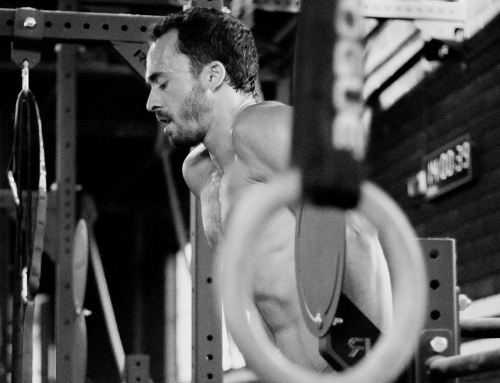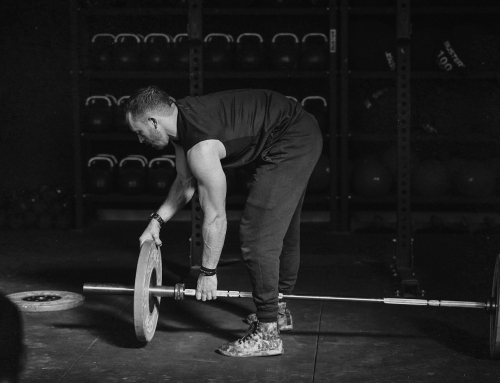La demanda de energía durante el ejercicio de alta intensidad (HIE) que parte de los procesos anaeróbicos, requieren una alta y extensa demanda de energía, la cual parte del trifosfato de adenosina (ATP). Como resultados, en una contracción explosiva repetitiva, tenemos una liberación de energía con el consecuente agotamiento de la fosfocreatina (PCr) y la acumulación de ácido láctico, lo que establece un límite minante en la producción de ATP y por lo tanto el rendimiento anaeróbico (HIE). Este estudio Sports Med. 2014 Nov;44 se centra en los efectos del entrenamiento y suplementos ergogénicos de la energética muscular y el rendimiento de HIE. La capacidad anaeróbica (es decir, la cantidad de ATP que se puede producir) se determina por el contenido muscular de PCr, (depósitos de fosfocreatina) como la capacidad de regulación y el volumen de la masa muscular a contraer. Entrenamientos HIE pueden aumentar la capacidad reguladora y la masa muscular de contratación pero no tiene ningún efecto sobre la concentración de PCr. La suplementación dietética con creatina (Cr), bicarbonato, o beta-alanina ha documentado un efecto ergogénico. La suplementación dietética con Cr aumenta el contenido de PCr en el músculo con la mejora el rendimiento, especialmente durante períodos cortos repetidos de HIE. El efecto ergogénico de Cr está relacionado con un aumento en el almacenamiento en la regulación temporal y espacial de ATP y aumento de la capacidad reguladora del músculo. El Bicarbonato de carga aumenta el almacenamiento extracelular y podría mejorar el rendimiento durante el HIE,(este ultimo dato no es seguro) facilitando la eliminación de ácido láctico de los músculos contraídos. La suplementación con beta-alanina aumenta el contenido de carnosina muscular, lo que es un tampón intracelular endógeno. Está claro que el rendimiento durante HIE se puede mejorar mediante intervenciones que aumentan la capacidad de la producción anaeróbica de ATP, lo que sugiere que las restricciones energéticas (dietas en déficit calórico) establecen un límite para el rendimiento durante el HIE.
PDF original de la investigación
- Astrand P-O, Rodahl K, Dahl HA, Stromme SB. Textbook of work physiology: physiological bases of exercise. 3rd ed. New York: McGraw-Hill; 1986.
- Medbo JI, Mohn AC, Tabata I, et al. Anaerobic capacity determined by maximal accumulated O2 deficit. J Appl Physiol. 1988;64:50–60.
- Sahlin K. Comments on point: counterpoint: muscle lactate and H(+) production do/do not have a 1:1 association in skeletal muscle. Why add complexity/confusion to a simple issue? J Appl Physiol. 2011;110:1494.
- Fitts RH. Cellular, molecular, and metabolic basis of muscle fatigue. In: Rowell LB, Shepherd JT, editors. Handbook of physiology exercise: regulation and integration of multiple systems. New York: Oxford University Press; 1996. p. 1151–83.
- Juel C. Lactate-proton cotransport in skeletal muscle. Physiol Rev. 1997;77:321–58.
- Allen DG, Lamb GD, Westerblad H. Skeletal muscle fatigue: cellular mechanisms. Physiol Rev. 2008;88:287–332. CrossRef
- Sahlin K. Metabolic factors in fatigue. In: Hargreaves M, Spriet L, editors. Exercise metabolism. 2nd ed. Champaign: Human kinetics; 2006. p. 163–86.
- Sahlin K, Harris RC, Nylind B, et al. Lactate content and pH in muscle obtained after dynamic exercise. Pflugers Arch. 1976;367:143–9.CrossRef
- Harris RC, Hultman E, Nordesjo LO. Glycogen, glycolytic intermediates and high-energy phosphates determined in biopsy samples of musculus quadriceps femoris of man at rest. Methods and variance of values. Scand J Clin Lab Invest. 1974;33:109–20. CrossRef
- Bonen A, McCullagh KJ, Putman CT, et al. Short-term training increases human muscle MCT1 and femoral venous lactate in relation to muscle lactate. Am J Physiol. 1998;274:E102–7.
- Carr AJ, Hopkins WG, Gore CJ. Effects of acute alkalosis and acidosis on performance: a meta-analysis. Sports Med. 2011;41:801–14.CrossRef
- Katz A, Broberg S, Sahlin K, et al. Muscle ammonia and amino acid metabolism during dynamic exercise in man. Clin Physiol. 1986;6:365–79.CrossRef
- Sahlin K. Metabolic changes limiting muscle performance. In: Saltin B, editor. Biochemistry of exercise VI. Champaign: Human Kinetics; 1986. p. 323–45.
- Hultman E, Sjoholm H. Substrate availability. In: Knuttgen HG, Vogel JA, Poortmans J, editors. Biochemistry of exercise. Champaign: Human Kinetics; 1983. p. 63–75.
- Chasiotis D, Sahlin K, Hultman E. Regulation of glycogenolysis in human muscle at rest and during exercise. J Appl Physiol. 1982;53:708–15.CrossRef
- Sahlin K. High-energy phosphates and muscle energetics. In: Poortmans J, editor. Principles of exercise biochemistry. 3rd ed. Basel: Karger; 2004. p. 87–107.
- Gaitanos GC, Williams C, Boobis LH, et al. Human muscle metabolism during intermittent maximal exercise. J Appl Physiol. 1993;75:712–9.
- Harris RC, Edwards RH, Hultman E, et al. The time course of phosphorylcreatine resynthesis during recovery of the quadriceps muscle in man. Pflugers Arch. 1976;367:137–42. CrossRef
- Spriet LL, Lindinger MI, McKelvie RS, et al. Muscle glycogenolysis and H+ concentration during maximal intermittent cycling. J Appl Physiol. 1989;66:8–13.
- Saltin B, Gollnick PD. Skeletal muscle adaptability: significance for metabolism and performance. In: Peachey LD, Adrian RH, Geiger SR, editors. Handbook of physiology. Bethesda: American Physiological Society; 1983. p. 555–631.
- Ross A, Leveritt M, Riek S. Neural influences on sprint running: training adaptations and acute responses. Sports Med. 2001;31:409–25.CrossRef
- Johansen L, Quistorff B. 31P-MRS characterization of sprint and endurance trained athletes. Int J Sports Med. 2003;24:183–9. CrossRef
- Sahlin K. Intracellular pH and energy metabolism in skeletal muscle of man. With special reference to exercise. Acta Physiol Scand Suppl. 1978;455:1–56.
- Sahlin K, Conley KE. Determination of muscle pH and glycolytic flux by magnetic resonance spectroscopy in contracting human skeletal muscle may have systematic errors. Am J Physiol Cell Physiol. 2005;289:C230. CrossRef
- Bishop D, Edge J, Goodman C. Muscle buffer capacity and aerobic fitness are associated with repeated-sprint ability in women. Eur J Appl Physiol. 2004;92:540–7. CrossRef
- Bishop D, Edge J, Mendez-Villanueva A, et al. High-intensity exercise decreases muscle buffer capacity via a decrease in protein buffering in human skeletal muscle. Pflugers Arch. 2009;458:929–36. CrossRef
- Sharp RL, Costill DL, Fink WJ, et al. Effects of eight weeks of bicycle ergometer sprint training on human muscle buffer capacity. Int J Sports Med. 1986;7:13–7. CrossRef
- Weston AR, Myburgh KH, Lindsay FH, et al. Skeletal muscle buffering capacity and endurance performance after high-intensity interval training by well-trained cyclists. Eur J Appl Physiol Occup Physiol. 1997;75:7–13. CrossRef
- Mizuno M, Juel C, Bro-Rasmussen T, et al. Limb skeletal muscle adaptation in athletes after training at altitude. J Appl Physiol. 1990;68:496–502.
- Harris R, Söderlund K, Hultman E. Elevation of creatine in resting and exercised muscle of normal subjects by creatine supplementation. Clin Sci. 1992;83:367–74.
- Hultman E, Soderlund K, Timmons JA, et al. Muscle creatine loading in men. J Appl Physiol. 1996;81:232–7.
- Greenhaff PL, Casey A, Short AH, et al. Influence of oral creatine supplementation of muscle torque during repeated bouts of maximal voluntary exercise in man. Clin Sci. 1993;84:565–71.
- Harris B, Viru M, Greenhaff PL, et al. The effect of oral creatine supplementation on running performance during maximal short term exercise in man. J Physiol. 1993;467:74 abstract.
- Balsom PD, Ekblom B, Söderlund K, et al. Creatine supplementation and dynamic high-intensity intermittent exercise. Scand J Med Sci Sports. 1993;3:143–9. CrossRef
- Rawson ES, Volek JS. Effects of creatine supplementation and resistance training on muscle strength and weightlifting performance. J Strength Cond Res. 2003;17:822–31.
- Wallimann T, Wyss M, Brdiczka D, et al. Intracellular compartmentation, structure and function of creatine kinase isoenzymes in tissues with high and fluctuating energy demands: the ‘phosphocreatine circuit’ for cellular energy homeostasis. Biochem J. 1992;281:21–40.
- Korge P, Campbell KB. Local ATP regeneration is important for sarcoplasmic reticulum Ca2+ pump function. Am J Physiol. 1994;267:C357–66.
- Saks VA, Kuznetsov AV, Khuchua ZA, et al. Control of cellular respiration in vivo by mitochondrial outer membrane and by creatine kinase. A new speculative hypothesis: possible involvement of mitochondrial-cytoskeleton interactions. J Mol Cell Cardiol. 1995;27:625–45. CrossRef
- Walsh B, Tonkonogi M, Soderlund K, et al. The role of phosphorylcreatine and creatine in the regulation of mitochondrial respiration in human skeletal muscle. J Physiol. 2001;537:971–8. CrossRef
- van Leemputte M, Vandenberghe K, Hespel P. Shortening of muscle relaxation time after creatine loading. J Appl Physiol. 1999;86:840–4.
- Green AL, Hultman E, Macdonald IA, et al. Carbohydrate ingestion augments skeletal muscle creatine accumulation during creatine supplementation in humans. Am J Physiol. 1996;271:E821–6.
- Greenhaff PL, Bodin K, Soderlund K, et al. Effect of oral creatine supplementation on skeletal muscle phosphocreatine resynthesis. Am J Physiol. 1994;266:E725–30.
- Robinson TM, Sewell DA, Hultman E, et al. Role of submaximal exercise in promoting creatine and glycogen accumulation in human skeletal muscle. J Appl Physiol. 1999;87:598–604.
- Branch JD. Effect of creatine supplementation on body composition and performance: a meta-analysis. Int J Sport Nutr Exerc Metab. 2003;13:198–226.
- Sahlin K, Alvestrand A, Brandt R, et al. Intracellular pH and bicarbonate concentration in human muscle during recovery from exercise. J Appl Physiol. 1978;45:474–80.
- Roos A. Intracellular pH and distribution of weak acids across cell membranes. A study of D- and L-lactate and of DMO in rat diaphragm. J Physiol. 1975;249:1–25.
- Linderman JK, Gosselink KL. The effects of sodium bicarbonate ingestion on exercise performance. Sports Med. 1994;18:75–80. CrossRef
- Bishop DJ, Thomas C, Moore-Morris T, et al. Sodium bicarbonate ingestion prior to training improves mitochondrial adaptations in rats. Am J Physiol Endocrinol Metab. 2010;299:E225–33.
- Edge J, Bishop D, Goodman C. Effects of chronic NaHCO3 ingestion during interval training on changes to muscle buffer capacity, metabolism, and short-term endurance performance. J Appl Physiol. 2006;101:918–25. CrossRef
- Carr AJ, Slater GJ, Gore CJ, et al. Effect of sodium bicarbonate on [HCO3 −], pH, and gastrointestinal symptoms. Int J Sport Nutr Exerc Metab. 2011;21:189–94.
- Siegler JC, Marshall PW, Bray J, et al. Sodium bicarbonate supplementation and ingestion timing: does it matter? J Strength Cond Res. 2012;26:1953–8. CrossRef
- Mc Naughton L, Thompson D. Acute versus chronic sodium bicarbonate ingestion and anaerobic work and power output. J Sports Med Phys Fit. 2001;41:456–62.
- Dunnett M, Harris RC. Influence of oral beta-alanine and L-histidine supplementation on the carnosine content of the gluteus medius. Equine Vet J Suppl. 1999;30:499–504.
- Hill CA, Harris RC, Kim HJ, et al. Influence of beta-alanine supplementation on skeletal muscle carnosine concentrations and high intensity cycling capacity. Amino Acids. 2007;32:225–33. CrossRef
- Sale C, Saunders B, Harris RC. Effect of beta-alanine supplementation on muscle carnosine concentrations and exercise performance. Amino Acids. 2010;39:321–33. CrossRef
- Abe H. Role of histidine-related compounds as intracellular proton buffering constituents in vertebrate muscle. Biochemistry (Mosc). 2000;65:757–65.
- Parkhouse WS, McKenzie DC, Hochachka PW, et al. Buffering capacity of deproteinized human vastus lateralis muscle. J Appl Physiol. 1985;58:14–7.
- Hobson RM, Saunders B, Ball G, et al. Effects of beta-alanine supplementation on exercise performance: a meta-analysis. Amino Acids. 2012;43:25–37. CrossRef
- Geyer H, Parr MK, Mareck U, et al. Analysis of non-hormonal nutritional supplements for anabolic-androgenic steroids—results of an international study. Int J Sports Med. 2004;25:124–9. CrossRef



